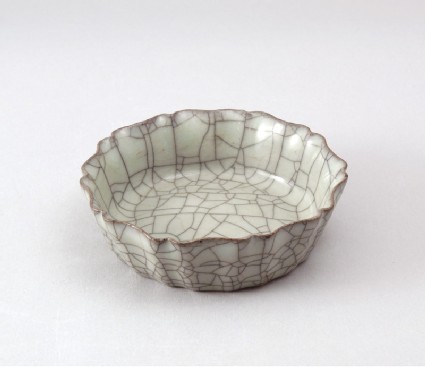The Barlow Collection
A select catalogue of the Barlow collection of Chinese Ceramics, Bronzes and Jades by the University of Sussex (published Sussex, 2006).

Publications online: 456 objects
Guan ware brush washer
- on display
- loan
-
Literature notes
When the Song (AD 960–1279) lost the northern part of their empire to the Jin dynasty (1115-1234) and moved the capital south to Hangzhou in 1127, they also lost access to the best ceramic manufactories of the north. Official (guan) kilns were therefore set up in the capital to supply the court. Although they copied the finest wares of the north, notably ‘Ru’ (see [LI1301.229]), with the southern materials the results were quite different and established a new style. Guan ware became so highly regarded that it has been imitated ever since.
The small piece is finely potted and richly glazed, the everted sides shaped in ten double-lobed foliations, which continue onto the footring, the base is domed on the inside, concave on the underside, where the glaze shows five small dot-shaped spur marks. The piece is otherwise fully covered with a rich bluish-grey glaze of extremely smooth texture, thinning to reveal the dark clay at the rim, and displaying an attractive even dark-stained crackle overall. -
Details
- Associated place
-
Asia › China › Zhejiang province › Hangzhou (Guan kiln) (place of creation)
- Date
-
12th century (1101 - 1200)
Southern Song Dynasty (AD 960 - 1127)
- Material and technique
- stoneware, thrown, with blue crackled glaze; glazed base; glazed rim
- Dimensions
-
3.4 cm (height)
11.8 cm (diameter)
- Material index
- Technique index
- Object type index
- No. of items
- 1
- Credit line
- Lent by the Sir Alan Barlow Collection Trust.
- Accession no.
- LI1301.48
-
Further reading
University of Sussex, and Arts and Humanities Research Council, The Barlow Collection, supervised by Regina Krahl, Maurice Howard, and Aiden Leeves (Sussex: University of Sussex, 2006), no. C12
Glossary (2)
glaze, stoneware
-
glaze
Vitreous coating applied to the surface of a ceramic to make it impermeable or for decorative effect.
-
stoneware
Ceramic material made of clay which is fired to a temperature of c.1200-1300⁰c and is often buff or grey in colour.
Location
Objects are sometimes moved to a different location. Our object location data is usually updated on a monthly basis. Contact the Jameel Study Centre if you are planning to visit the museum to see a particular object on display, or would like to arrange an appointment to see an object in our reserve collections.
Galleries
Publications online
-

The Barlow Collection
When the Song (AD 960–1279) lost the northern part of their empire to the Jin dynasty (1115-1234) and moved the capital south to Hangzhou in 1127, they also lost access to the best ceramic manufactories of the north. Official (guan) kilns were therefore set up in the capital to supply the court. Although they copied the finest wares of the north, notably ‘Ru’ (see [LI1301.229]), with the southern materials the results were quite different and established a new style. Guan ware became so highly regarded that it has been imitated ever since.
The small piece is finely potted and richly glazed, the everted sides shaped in ten double-lobed foliations, which continue onto the footring, the base is domed on the inside, concave on the underside, where the glaze shows five small dot-shaped spur marks. The piece is otherwise fully covered with a rich bluish-grey glaze of extremely smooth texture, thinning to reveal the dark clay at the rim, and displaying an attractive even dark-stained crackle overall.
Notice
Object information may not accurately reflect the actual contents of the original publication, since our online objects contain current information held in our collections database. Click on 'buy this publication' to purchase printed versions of our online publications, where available, or contact the Jameel Study Centre to arrange access to books on our collections that are now out of print.
© 2013 University of Oxford - Ashmolean Museum











